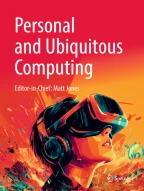Avoid common mistakes on your manuscript.
This theme issue of Personal and Ubiquitous Computing is a follow-up to the International Symposium of Wearable Computers 2013, held in Zurich, Switzerland, September 8–12, 2013. ISWC continues a young tradition of collocation with Ubicomp, the ACM International Joint Conference on Pervasive and Ubiquitous Computing. ISWC is the premier forum for wearable computing and topics related to on-body and worn mobile technologies.
In the autumn of 2013, the authors of the five papers nominated for the Best Paper Award at the conference were invited to expand their work and submit extended journal versions of their ISWC 2013 contributions. The five papers were subjected to a peer review process following the standard Personal and Ubiquitous Computing process, where anonymous reviewers were appointed by the Guest Editors. In cases of papers with conflict of interest, one of the not-in-conflict Guest Editors coordinated the review. Acceptance decisions were reached independently for each paper. The review process resulted in the acceptance of four papers for publication.
Activity recognition through sensing and machine learning is a classic problem in wearable computing; the emergence of a variety of commercial devices related to fitness and health is living proof of the relevance of this domain. In “A Novel Confidence-based Multiclass Boosting Algorithm for Mobile Physical Activity Monitoring,” Reiss et al. present a variation of the well-known AdaBoost.M1 classification technique to improve multi-class activity recognition performance. Through the introduction of information about how confidently weak learners make predictions, the authors show benefits for both activity recognition and intensity estimation tasks, and the potential of the technique for online activity monitoring.
Activity recognition research is also expanding to achieve multiple goals through integrated sensing and inference frameworks. In “3D ActionSLAM: Wearable Person Tracking in Multi-Floor Environments,” Hardegger et al. address a relevant problem that has connection to robotics, namely action-based joint localization and mapping. Their proposed system integrates dead reckoning data coming from foot-mounted IMUs with recognition of location-based actions, in order to construct and maintain local landmark maps. The authors show in experiments that the system is able to track individuals with sub-room accuracy in previously unseen environments involving multiple floors, which points to the potential of these approaches in smart buildings.
Wearable computing often calls for new means of seamless interactions to avoid distracting users from their primary task. A common mechanism for a wearable to convey information to the user is through audio feedback with earphones. Manabe et al. explain in “Conductive Rubber Electrodes for Earphone-Based Eye Gesture Input Interface” how earphones can be enhanced to allow the user to convey information back to the system. They enhance an earphone with electrodes to detect eye gestures from electrooculography. One of the main challenges in wearable scenarios is the presence of motion artifacts. The authors show that appropriate mechanical design and material choice are crucial to minimize these artifacts.
Finally, wearable devices on humans are often used as part of assistive technologies. However, there is still a large range of scenarios where worker animals, more specifically dogs, remain the primary way in which assistance is provided, for instance, to the visually or hearing impaired. Jackson et al. seek to enhance the abilities of worker dogs in their paper “FIDO—Facilitating Interactions for Dogs with Occupations: Wearable Communication Interfaces for Working Dogs.” The authors developed and characterized sensors integrated into the vest of worker dogs, which can be activated after appropriate training. The wearable interface allows dogs to convey information digitally and remotely. This opens up a new dimension in wearable assistance, where worker dogs can complement and inform traditional wearable, “on-the-user” devices or ambient-assisted living environments.
Taken together, the theme issue provides a sample of state-of-the-art wearable computing research. We would like to thank the authors for their commitment to submit significantly improved papers on time, and to further revise them based on the reviewers’ feedback. We would also like to thank the reviewers for their timely response. Finally, we thank Professor Peter Thomas, PUC’s Editor-in-Chief, who supported the edition of this theme issue and who has also supported similar initiatives in the last years.
Author information
Authors and Affiliations
Corresponding author
Rights and permissions
About this article
Cite this article
Gatica-Perez, D., Roggen, D. & Fukumoto, M. Theme issue from ISWC 2013. Pers Ubiquit Comput 19, 103–104 (2015). https://doi.org/10.1007/s00779-014-0814-z
Published:
Issue Date:
DOI: https://doi.org/10.1007/s00779-014-0814-z
